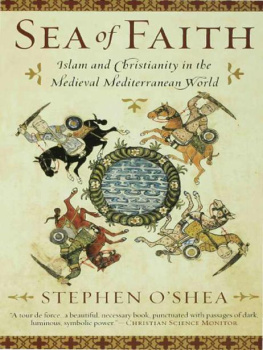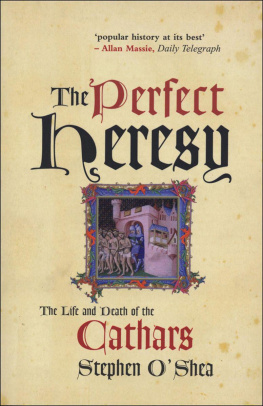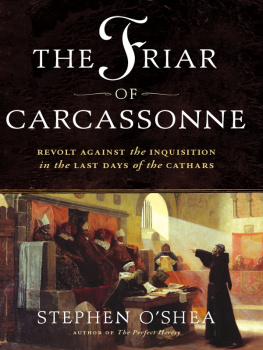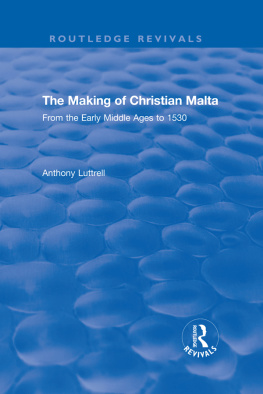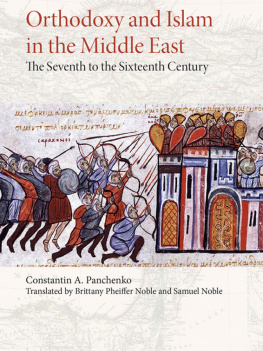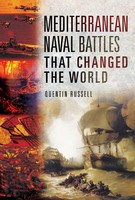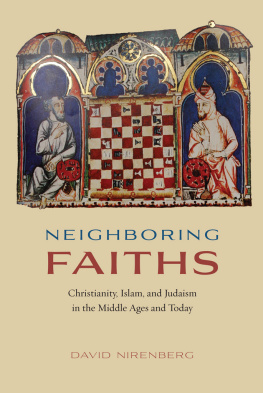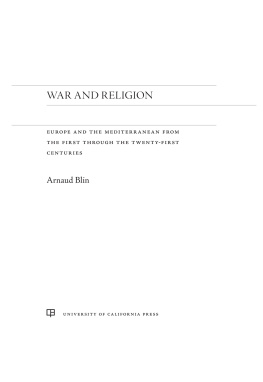All rights reserved. No part of this book may be used or reproduced in any manner whatsoever without written permission from the publisher except in the case of brief quotations embodied in critical articles or reviews. For information address Walker & Company, 104 Fifth Avenue, New York, New York 10011.
O'Shea, Stephen.
Sea of faith : the shared story of Christianity and Islam in the medieval Mediterranean world / Stephen O'Shea.
p. cm.
Includes bibliographical references (p. ) and index.
1. Mediterranean RegionHistory, Military. 2. Islamic EmpireHistory, Military. 3. EuropeHistory, Military. 4. BattlesMediterranean RegionHistory. 5. East and West. I. Title.
T he goal of reducing obstacles in the reader's path sometimes leads to inconsistency, which, to my mind, is a benign vice when compared to the mischief inflicted on prose by an excess of scruples. As this narrative touches on different peoples, places, and eras, a few decisions had to be made to smooth the journey.
All dates are given in the western manner, with reference to the Common Era and, as tact dictates, not to Anno Domini, the Year of our Lord. Dual datesone western, one Islamicfor every event would make eyes glaze over. Similarly, the period covered in the book is called the Middle Ages, or the medieval era, for the sake of convenience and familiarity, even if in al-Andalus and Mesopotamia a classical period or golden age existed at some point within the millennium.
Geographical areas are at times referred to by their present-day nation-state names (e.g., France, Iraq) solely as a means of speeding comprehension and avoiding digressions. Similarly, readabilitynot consistencyhas been the guideline in the choice of names of people. The simpler versions of nonwestern names have been retained. Where western versions of names exist (e.g., Almanzor, Avicenna), they have been used. As for the Europeans, not all of their names are anglicized: I simply couldn't call the bad boy of Outremer, as some authors do, Reginald of Chatillon. And if a non-English name is perfectly serviceablePedro and not Peter, for exampleit has been let stand.
As for the vexed problem of transliteration, I have opted for the simplest form possible. Arabists and Turkophones may despair, but many of the macrons, dots, and apostrophes of scholarly and present-day transliteration have been abandoned. As someone whose surname is no stranger to punctuation, I may be accused of chutzpah in this decision, but, again, the intent is to clear the path of obstacles. I do, however, employ several terms that might at the outset be unfamiliar convivencia, umma, and the like. I trust that the reader, as she or he progresses through the narrative, will have been made familiar with these terms. If the writing or the memory fails in this respect, a glossary can be flipped to at the back of the book.
S EA of F AITH
Mezquita and Ayasofya
C rdoba's white warren of cobbled streets and courtyards stretches out alongside the dull bleached banks of the Guadalquivir River. The old town is a capital of traditional Spanish culture, and its many merchants obligingly peddle the customary flamencoparty finery and plastic conquistador gear. Yet in the heart of its historic center, Crdoba, defies shopworn narrative through its proud possession of an unusual architectural marvel. The city's magnificent MezquitaSpanish for "mosque"bespeaks another heritage, another memory, another story altogether. To those attuned to the historic struggle over Mediterranean identity, this remarkable building offers two encounterstwo moments of realization that shape this present work.
The first encounter occurs quickly. Once past the patio of orange trees and through the main portal, the eye and ear are forced to adjust. Intermittent blizzards of flashbulbs lance the dimness, accompanied by the voices of tour leaders shepherding their charges through the sanctuary. But these distractions fade in their turn as the interior takes shape. Row upon row of slender marble columns, twice the height of a man, march across a cool stone floor. For all the regimentation, the effect is not one of parade-ground monotony. Quite the contrarythe exquisite paradox of the Mezquita lies in its creation of dreamlike, shifting expanses along what is essentially a grid.
The capitals of adjacent columns in each row are joined by tall semicircular arches, their building blockscalled voussoirs distinctive for their alternating bands of red brick and white stone. To this shock of color comes an even greater surprise of volume: surmounting each arch is a sister arch, similarly striped, creating a crescent of emptiness between the paired curves of stone that is endlessly reproduced throughout the mosque. The peekaboo succession of spaces enlivens perspective no matter which way the visitor turns, the candy-cane interior seeming to shift repeatedly, all at once, like a Muslim congregation at prayer.
Abd al-Rahman, the Cordoban grandee who commissioned this astonishing mosque in the eighth century C.E., had firsthand knowledge of sudden changes and dramatic new perspectives. As an Umayyad, a descendant of the caliphs who had ruled the early Muslim world from their capital of Damascus, he had been forced to flee his native Syria in 750 when a rival clan, the Abbasids, seized power under the leadership of Abu al-Abbas as-Saffah. The sobriquet as-Saffah means "shedder of blood"the Umayyads were slaughtered to a man. Only Abd al-Rahman escaped the carnage, riding the length of the Mediterranean until reaching distant Spain and making it his kingdom.
Interior of the Mezquita of Crdoba,, famed for its striped,
superimposed arches and arresting perspectives.
Abd al-Rahman and his successors in Crdoba, built and expanded the Mezquita for the next two centuries, the last and largest of these additions occurring under the rule of Almanzor, a ruthless vizier who wielded the real power behind a puppet Umayyad prince. Aside from doubling the size of the Mezquita, all the while maintaining its striped double-horseshoe colonnades, Almanzor added metal lamps that were fashioned from the bells he had stolen in his sack of Compostela, in the northwestern extremity of Spain. That event, in 997, had entailed desecrating the shrine of a saint who would inspire a devotional frenzy in the Middle Ages. The bells of Santiago MatamorosSt. James the Moor-Slayerhung harmless in Almanzor's Mezquita, illuminating the pointedly unslain Moors as they thanked God for their vizier's victory.

